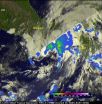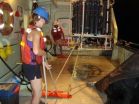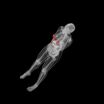(Press-News.org) Tropical Depression 2E strengthened into Tropical Storm Boris briefly on June 3 before making landfall in southern Mexico and weakening into a depression. While Boris was building to tropical storm strength, NASA's Aqua and TRMM satellites passed overhead identifying heavy rainfall and the extent of the storm.
On June 3 at 19:15 UTC (3:15 p.m. EDT) the Moderate Resolution Imaging Spectroradiometer (MODIS) instrument aboard NASA's Aqua satellite captured a visible image of Tropical Storm Boris over Central America. Boris appeared circular in the imagery and its clouds covered southern Mexico and stretched over the border into northern Guatemala. The MODIS image also showed that clouds associated with a low pressure in the southwestern Gulf of Mexico, specifically, in the Bay of Campeche, were just to the north of Boris.
Earlier in the day at 06:02 UTC (2:02 a.m. EDT), NASA and the Japan Aerospace Exploration Agency's Tropical Rainfall Measuring Mission (TRMM) satellite passed over Boris. TRMM gathered data about rainfall rates occurring within the depression (at the time). TRMM showed that rain near the center was falling at a rate of over 61 mm (2.4 inches) per hour. A National Hurricane Center (NHC) discussion at the time noted "The cloud pattern has become elongated and is possible that the low-level center is on the southern edge of the convection due to wind shear. This is supported by a 0600 UTC TRMM pass which shows what appears to be a center located south of the thunderstorm activity."
At 5 p.m. EDT on June 3 Boris' maximum sustained winds increased to 40 mph (65 kph) and the storm was named and classified as a tropical storm. Boris made landfall around 06:00 UTC (2 a.m. EDT) today, June 4. By 11 a.m. EDT, Boris had weakened to a tropical depression but was soaking southern Mexico.
The National Hurricane Center (NHC) noted that heavy rain and flash flooding remains a threat as Boris moves slowly over southern Mexico.
At 11 a.m. EDT on June 4, Boris was centered near 16.4 north latitude and 94.0 west longitude, about 80 miles (130 km) east of Salina Cruz, Mexico. Maximum sustained winds were near 30 mph (45 kph). Boris was crawling to the north at 2 mph (4 kph).
As indicated by the earlier TRMM satellite image, heavy rainfall is a component of Boris, and its slow movement is exacerbating the localized rainfall amounts. The National Hurricane Center noted that "Boris could still produce additional rainfall amounts of 4 to 8 inches with isolated amounts of up to 10 inches over the Mexican states of Oaxaca, Chiapas, Veracruz and Tabasco. These rains will bring isolated storm total amounts to as much as 20 inches especially over the higher terrain. These rains are likely to result in life-threatening flash floods and mud slides."
The Mexican Weather Service reported the city of Tonala on the coast of Chiapas has already recorded 12.5 inches (318 mm) of storm-total rainfall.
NHC expects that Boris will dissipate later today while it moves slowly northward and becomes a part of a large trough of low pressure extending from across the Isthmus of Tehuantepec northward into the Bay of Campeche. Once together, NHC expects the two systems to continue to produce very heavy rainfall over parts of Mexico.
INFORMATION:
NASA sees Depression Boris mOVING over Mexico with heavy rainfall
2014-06-04
ELSE PRESS RELEASES FROM THIS DATE:
Scientist uses fossils to prove historic Ohio millstones have French origins
2014-06-04
Cleveland . . . A geologist studied fossils to confirm that stones used in 19th century Ohio grain mills originated from France. Fossils embedded in these millstones were analyzed to determine that stones known as French buhr were imported from regions near Paris, France, to Ohio in the United States.
Dr. Joseph Hannibal, curator of invertebrate paleontology at The Cleveland Museum of Natural History, was lead author on research published in the Society for Sedimentary Geology journal PALAIOS.
The study documents a technique that uses fossils to definitively distinguish ...
Cleaning the air with roof tiles
2014-06-04
RIVERSIDE, Calif. (http://www.ucr.edu) — A team of University of California, Riverside's Bourns College of Engineering students created a roof tile coating that when applied to an average-sized residential roof breaks down the same amount of smog-causing nitrogen oxides per year as a car driven 11,000 miles.
They calculated 21 tons of nitrogen oxides would be eliminated daily if tiles on one million roofs were coated with their titanium dioxide mixture. They also calculated it would cost only about $5 for enough titanium dioxide to coat an average-sized residential roof.
That ...
Mayo Clinic researchers decode how the brain miswires, possibly causing ADHD
2014-06-04
JACKSONVILLE, Fla. — Neuroscientists at Mayo Clinic in Florida and at Aarhus University in Denmark have shed light on why neurons in the brain's reward system can be miswired, potentially contributing to disorders such as attention deficit hyperactivity disorder (ADHD).
They say findings from their study, published online today in Neuron, may increase the understanding of underlying causes of ADHD, potentially facilitating the development of more individualized treatment strategies.
The scientists looked at dopaminergic neurons, which regulate pleasure, motivation, ...
GW Cancer Institute conducts survey on moving toward quality patient-centered care
2014-06-04
WASHINGTON (June 4, 2014) — In order to meet new cancer program accreditation standards, institutions have placed new focus on patient navigation, psychosocial distress screening, and survivorship care plans. Recently published research by the George Washington University (GW) Cancer Institute found these new programs are experiencing "growing pains." The results of a nationwide survey conducted by the GW Cancer Institute and reviewed in the Journal of Oncology Navigation and Survivorship, found that health care professionals could most benefit from greater evaluation of ...
Hemorrhagic fevers can be caused by body's antiviral interferon response
2014-06-04
LA JOLLA, CA—June 4, 2014— Hemorrhagic fevers caused by Lassa, dengue and other viruses affect more than one million people annually and are often fatal, yet scientists have never understood why only some virus-infected people come down with the disease and others do not.
But now, virologists and immunologists at The Scripps Research Institute (TSRI) have found a major clue to the mystery of "hemorrhagic fever" syndromes. In findings reported this week in an Early Edition of the Proceedings of the National Academy of Sciences, the team showed that Interferon Type I (IFN-I) ...
Astronomers discover first Thorne-Zytkow object, a bizarre type of hybrid star
2014-06-04
In a discovery decades in the making, scientists have detected the first of a "theoretical" class of stars first proposed in 1975 by physicist Kip Thorne and astronomer Anna Żytkow. Thorne-Żytkow objects (TŻOs) are hybrids of red supergiant and neutron stars that superficially resemble normal red supergiants, such as Betelguese in the constellation Orion. They differ, however, in their distinct chemical signatures that result from unique activity in their stellar interiors.
TŻOs are thought to be formed by the interaction of two massive stars―a ...
How red tide knocks out its competition
2014-06-04
New research reveals how the algae behind red tide thoroughly disables – but doesn't kill – other species of algae. The study shows how chemical signaling between algae can trigger big changes in the marine ecosystem.
Marine algae fight other species of algae for nutrients and light, and, ultimately, survival. The algae that cause red tides, the algal blooms that color blue ocean waters red, carry an arsenal of molecules that disable some other algae. The incapacitated algae don't necessarily die, but their growth grinds to a halt. This could explain part of why blooms ...
New diagnostic imaging techniques deemed safe in simulations
2014-06-04
DURHAM, N.C. -- Gamma and neutron imaging offer possible improvements over existing techniques such as X-ray or CT, but their safety is not yet fully understood. Using computer simulations, imaging the liver and breast with gamma or neutron radiation was found to be safe, delivering levels of radiation on par with conventional medical imaging, according to researchers at Duke Medicine.
The findings, published in the June issue of the journal Medical Physics, will help researchers to move testing of gamma and neutron imaging into animals and later humans.
Conventional ...
Study: When hospital workers get vaccines, community flu rates fall
2014-06-04
Anaheim, Calif., June 4, 2014 – For every 15 healthcare providers who receive the influenza vaccination, one fewer person in the community will contract an influenza-like illness, according to a study using California public health data from 2009 – 2012.
In an abstract that will be presented on June 7 at the 41st Annual Conference of the Association for Professionals in Infection Control and Epidemiology (APIC), a researcher analyzed archival data from the California Department of Public Health to determine the relationship between vaccinating healthcare personnel against ...
MU scientists successfully transplant, grow stem cells in pigs
2014-06-04
COLUMBIA, Mo. – One of the biggest challenges for medical researchers studying the effectiveness of stem cell therapies is that transplants or grafts of cells are often rejected by the hosts. This rejection can render experiments useless, making research into potentially life-saving treatments a long and difficult process. Now, researchers at the University of Missouri have shown that a new line of genetically modified pigs will host transplanted cells without the risk of rejection.
"The rejection of transplants and grafts by host bodies is a huge hurdle for medical researchers," ...







